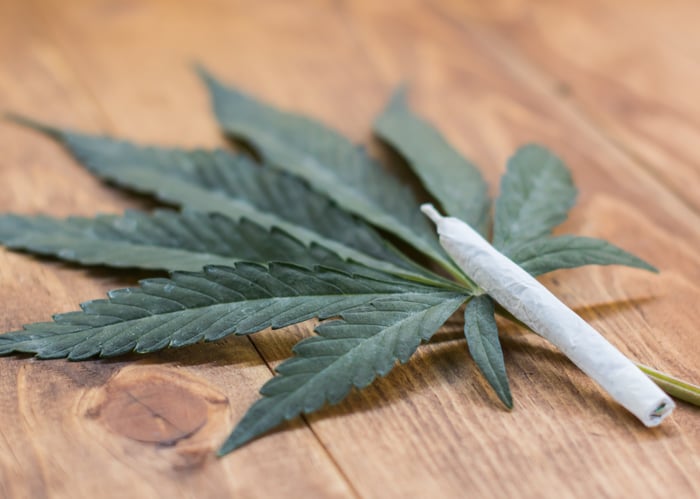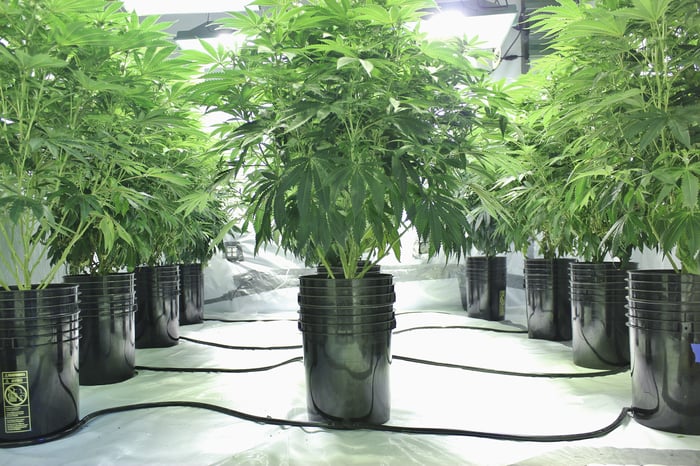When it comes to the stock market's fastest-growing industries, chances are that legal marijuana is at or near the top of the list. According to cannabis research firm ArcView, the North American legal marijuana industry is set to grow by an estimated 28% per year through 2021.
Between 2017 and 2027, ArcView envisions the North American industry expanding from $9.7 billion in annual sales to more than $47 billion. This sales growth has been difficult to ignore, which is a big reason why pot stocks have exploded higher over the past couple of years.
But with big gains has come wild volatility. Beneath these growth estimates is a drug that's still illegal in every country around the world, except for Uruguay. Investing in a product that isn't guaranteed to thrive and could disappear based on the desire of lawmakers to enforce federal law is a risky proposition.

Image source: Getty Images.
Also, most publicly traded cannabis stocks don't have access to basic banking services, meaning access to capital can be challenging. Many have turned to common stock offerings or bought-deal offerings in Canada in order to raise capital. In doing so, the outstanding share counts of marijuana stocks has ballooned, diluting existing shareholders and making it tougher for pot stocks to turn a meaningful per-share profit.
In short, pure-play marijuana stocks are risky and certainly not for all investors.
Want marijuana exposure without the high risks? Check out these stocks
However, you don't necessarily have to buy a pure-play pot stock to benefit from the expansion of the cannabis industry. There's a growing secondary market of companies that have some exposure to the legal cannabis movement -- i.e., cannabis use or growth represents or adds a small percentage of their revenue -- but with far less risk than buying a pure-play pot stock. Here are three for your consideration.
Scotts Miracle-Gro
One way to hedge your bet on the cannabis industry is to consider a company like Scotts Miracle-Gro (SMG). Scotts is best known for its lawn- and garden-care products that comprised about 89% of its total sales in 2017. This is an industry that can be impacted by weather and consumers' perception of the U.S. economy, but is generally steady and tends to grow by a mid-single-digit percentage over the long run.

Image source: Getty Images.
Exposure to the legal weed industry comes from the company's underlying Hawthorne Gardening segment, which accounted for the other 11% of sales in 2017. Hawthorne provides hydroponic solutions (growing plants in a nutrient-rich water solvent), as well as lighting, soil, and nutrients for the medical cannabis industry. Last year, Hawthorne's sales shot up by 137%, inclusive of acquisitions, with organic growth of 20%.
Last month, Scotts Miracle-Gro announced a $450 million acquisition of Sunlight Supply, which is the largest hydroponic distributor in the United States. Putting itself in position to dominate the hydroponics market, as well as add $0.60 to $0.80 in adjusted earnings per share (EPS) in 2019, probably sounds like a great move to shareholders.
But understand that even companies with secondary exposure can suffer hiccups. Scotts Miracle-Gro announced in its second-quarter results, released on May 1, that sales at Hawthorne dropped 29% from the year-ago quarter. Scotts has blamed slower-than-expected regulatory approvals in California for the weakness in its results and is now forecasting flat sales for Hawthorne on a year-over-year basis in 2018, including the impact of acquisitions.
Cree
Another stock with marijuana industry exposure, but with far less risk than a pure-play pot stock, is LED lights and lighting-system manufacturer Cree (WOLF -1.69%).

Image source: Getty Images.
Traditionally, marijuana growers have used high-pressure sodium (HPS) lights for their crops. These time-tested lights usually offer predictable yield, but come with a few drawbacks. For starters, they tend to generate a lot of heat, which means growers may have to use expensive climate-control systems to optimize growth. The other issue is that HPS lights use a lot of electricity, which can lead to very large electric bills for growers.
Cree, on the other hand, offers growers a means to resolve these issues. LED lights use considerably less electricity than HPS lights, produce far less heat, and can last a lot longer than traditional HPS lights. All of these factors should reduce long-term operating costs.
The downside? LED lights cost significantly more upfront and there's no concrete consensus among growers as to whether LED lights can deliver the same crop yield as traditional HPS lights.
Cree has yet to break down what percentage of sales that's derived, or believed to be derived, from the marijuana industry. However, this investor wouldn't discount the possibility of double-digit annual sales growth to the cannabis industry over the next five to 10 years.
Jack in the Box
Investors also shouldn't discount the possibility of fast-casual restaurant chains benefiting from the ongoing expansion of cannabis. After all, one of the side effects of smoking or ingesting cannabis is increased appetite, which is commonly referred to as "the munchies."

Image source: Jack in the Box.
For example, fast-casual restaurant chain Jack in the Box (JACK 0.86%) aimed to take advantage of the burgeoning cannabis culture earlier this year by piloting a test meal with Snoop Dogg's cannabis-focused digital media company Merry Jane. In select California locations, Jack in the Box began offering a meal catering to cannabis users. "Jack's Munchie Meals," as they were known, were priced at $4.20 -- a code term referring to cannabis use -- and included two tacos, five mini churros, three chicken strips, a box filled with half curly fries and half onion rings, and a drink.
Jack in the Box was also singled out by investment firm Cowen & Co. as the top marijuana stock play in the fast-food industry. Cowen & Co. is by far the most bullish of all investment firms on the U.S. and global cannabis market.
A September 2016 note from Cowen Group analyst Andrew Charles, courtesy of Investor's Business Daily, showed that 52% of the company's store base were in states expected to legalize in November 2016. Even though Arizona failed to legalize at that time -- albeit four other states approved recreational pot initiatives -- this still means that close to half of all Jack in the Box restaurants are located in adult-use legal states.
It's unclear what sort of revenue bump Jack in the Box has felt from its attempt to connect with late-night cannabis users, but the potential for a modest uptick in sales and profitability is certainly there.
